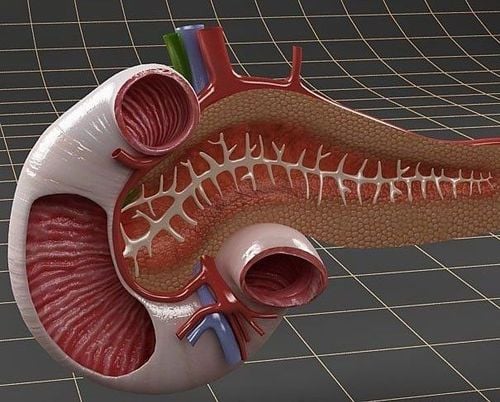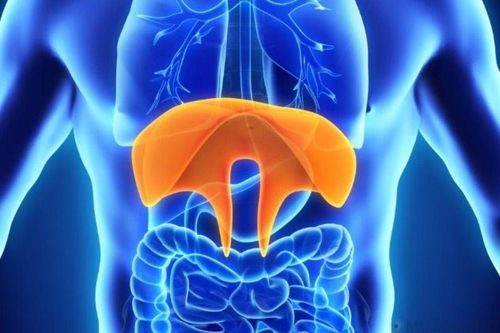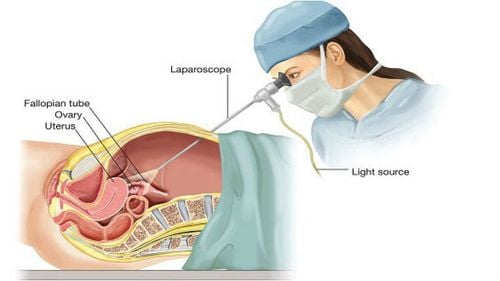This is an automatically translated article.
Duodenal rupture is a rare occurrence in blunt abdominal trauma, accounting for only 3-5% of all trauma cases. However, this is a difficult case to handle because the postoperative complication rate is as high as 50% and the mortality rate is up to 20%.
1. Signs of duodenal rupture in blunt abdominal trauma
After trauma, the patient feels abdominal pain, difficulty Closed abdominal trauma is an injury to the abdomen, the injuries can be in the abdominal wall or in the internal organs leading to acute blood loss or peritonitis depending on the patient's condition. in various organ injuries.
The duodenum has a C-shaped shape and is about 25cm long, located at the common position between the stomach and small intestine, which can be understood as the first part of the small intestine.
Duodenal rupture is difficult to diagnose because duodenal injury is often accompanied by other intra-abdominal visceral lesions. The cause of duodenal rupture in blunt abdominal trauma is mostly due to various accidents such as traffic accidents (mostly), occupational accidents...
When the duodenum ruptures, patients often have signs following:
1.1 Functional signs Open, unable to defecate and defecate, clear signs of infection if left for too long, the patient often has a fever as high as 40 degrees.
1.2 Signs on the body The abdominal wall appears bruised, the abdomen is tight, when pressed, the abdomen is painful.
2. Diagnosis of duodenal rupture in blunt abdominal trauma

Xét nghiệm máu để chuẩn đoán vỡ tá tràng trong chấn thương bụng kín
From the above signs, the doctor will make clinical conclusions about the disease, then continue to use laboratory tests to make a final diagnosis.
Tests include:
Blood count test: Low red blood cell and white blood cell count helps to diagnose the disease early X-ray of the abdomen is not prepared with a sickle CT Scan to evaluate the extent of damage as well as other lesions if present Abdominal ultrasound with free fluid Abdominal lavage with digestive juices
3. Four degrees of duodenal rupture in blunt abdominal trauma and treatment
There are many ways to classify duodenal lesions, currently the most used method is the 1990 AAST classification with four degrees of duodenal rupture:
Grade 1: Incomplete duodenal perforation, the pancreas is not traumatized , there is a hematoma in the duodenal wall. Grade 2: The duodenum is completely perforated, but the pancreas remains uninjured. Grade 3: There are signs of grade 1 or 2, accompanied by mild pancreatic injury such as pancreatic contusion, pancreatic hematoma or pancreatic tear but no damage to the main pancreatic duct. Grade 4: Severe rupture of the duodenum and damage to the head of the pancreas.
4. Treatment of duodenal rupture

Loại bỏ tá tràng ra khỏi đường tiêu hóa đối với phương pháp phẫu thuật cắt bỏ
Depending on the degree of duodenal rupture, the doctor will offer the most appropriate treatment plan for the patient with the principle of treatment is to minimize the amount of fluid and food passing through the duodenum, helping the wound to heal quickly and limit Management of complications of duodenal rupture after surgery for duodenal-conserving surgery. Removal of the duodenum from the gastrointestinal tract for surgical resection.
4.1 Conservative treatment For grades 1 to 3, methods such as simple suturing can be used if the duodenum is not excessively ruptured.
Duodenal suture combined with protective surgery: Open decompression, diverticulitis, and pylorus exclusion. Loop anastomosis: commonly used for grade 4 duodenal rupture For wounds on D4, the duodenojejunostomy can be resected and the jejunojejunostomy can heal 4.2 Resection treatment Indications for grade 4 lesions, including pancreaticoduodenectomy, total pancreaticoduodenectomy.
5. Complications after surgery
Some possible complications after duodenal rupture surgery include:
Duodenal fistula: This is the most common complication after 5 to 10 days after duodenal suture surgery. The patient presented with fever and abdominal pain. Post-operative suture causes peritonitis or retroperitoneal abscess Acute pancreatitis after surgery: With the rate up to nearly 15% Post-operative duodenal obstruction accounts for 8%, patients must be treated for at least 3-4 Weeks, if not effective, the doctor will recommend surgery again. Any questions that need to be answered by a specialist doctor as well as if you have a need for examination and treatment at Vinmec International General Hospital, please book an appointment on the website for the best service.
Please dial HOTLINE for more information or register for an appointment HERE. Download MyVinmec app to make appointments faster and to manage your bookings easily.













